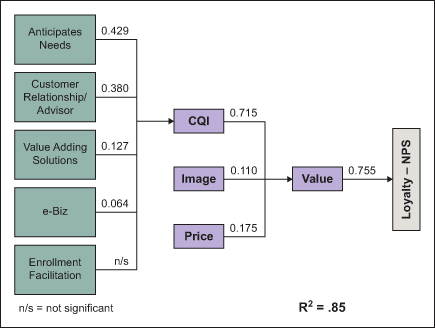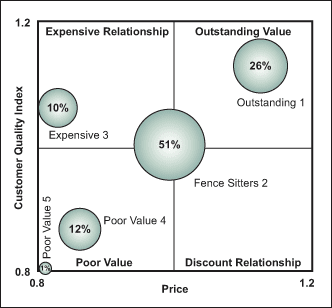
Organizations looking for a silver bullet customer metric look no further than the Net Promoter Score (NPS). Developed by Frederick Reichhold and his colleagues at Bain & Co., NPS provides an economical and concise metric for assessing how loyal a company’s customers are. Managing that measurement is the key to future growth.
What Is NPS?
NPS is both simple and compelling. Customers are asked, on a scale of 1 to 10, how likely they are to recommend a company to a friend. Respondents fall into one of three categories:
- Promoters (9 or 10) – customers who are highly likely to recommend a company or product
- Passives (7 or 8) – satisfied but unenthusiastic customers looking for a better deal
- Detractors (0 to 6) – people who are less likely to recommend a company or product
NPS is the percentage of promoters minus the percentage of detractors.
The Benefits of a High NPS
Having a high NPS, and loyal customers, means growth. Promoters account for 80 percent to 90 percent of positive word of mouth, according to “Reichheld’s New Metric: The Net Promoter Score,” an article on chiefmarketer.com. The net promoter leader grows at more than 2.5 times the rate of its competitors.
Bain & Co. publishes a list of selected NPS stars, all with scores of 50 percent to 80 percent. To achieve such stardom, a company needs to manage its NPS. This includes narrowing the focus for scores and considering the influence of value on loyalty.
Focusing on a Product/Market
If Dell has an NPS of 50 percent, does that refer to laptops sold to business people or desktops sold to home users, or servers sold to medium or large businesses? Many organizations serve more than one market and offer more than one product or service. Promoters and detractors will be specific to a product/market. By approaching NPS this way, companies can drill down and look at how to improve low NPSs and leverage high NPSs for greater market share and top line revenue. The following matrix provides a systematic way to view the NPSs of different products/markets.
| Table 1: Generalized Product/Market Matrix | ||||
|
Market |
Market |
Market |
Market |
|
| Product A |
NPSAA |
NPSAC |
||
| Product B |
NPSBB |
|||
| Product C |
NPSCD |
|||
|
Source: Competing for Customers and Winning With Value (ASQ Quality Press, 2006) |
||||
The intersection of a product line with a market segment creates a product/market – products bought by specific segments. So NPSAA corresponds to the NPS for product A sold to Segment A, NPSBB is product B sold to segment B, and so forth.
It is likely that a company may find a NPSAA that may be 30 points higher than NPSBB but 20 points lower than NPSAC. Each product/market will have its own success requirements. No single lever will change NPSs across all groups. Each must be managed according to the dynamics operating within the product/market that drive customers’ willingness to recommend it.
The Influence of Value
What is the best predictor of whether a customer is willing to recommend a product or service to a friend? Not customer satisfaction. Reichhold’s research shows it is difficult to discern a strong correlation between high customer satisfaction scores and outstanding sales growth.
What does correlate highly with profitability and sales is loyalty – exactly what NPS measures. But what is loyalty? Reichhold defines loyalty as “the willingness of someone – a customer, an employee, a friend to make an investment or personal sacrifice in order to strengthen a relationship. For a customer, that can mean sticking with a supplier who treats him well and gives him good value in the long term even if the supplier does not offer the best price in a particular transaction.”
Value is the key word. It is conceptually defined as the relationship between a product’s quality and the price paid for the product. New research by Reidenbach and Goeke also indicates that the brand and/or corporate image may play a significant role in the value definition. Value, like the NPS, is specific to a product/market and must be managed accordingly. It is the best predictor of loyalty and, therefore, NPS.
The following figure depicts a customer value model for an insurance company offering retirement services to large businesses. Data was obtained from a survey of benefit managers.

The model clearly points out how this company can improve its NPS within this specific product/market by examining value. The right-hand side of the model is the predictive side, showing the three value drivers – CQI (customer quality index), image and price – and their relative contributions to value. The model is generated using a regression algorithm and indicates a high degree of robustness (R2= .85). In other words, the three value drivers capture about 85 percent of what large businesses define as value with regard to retirement services offered by insurance companies. The greatest increases in value, and subsequently in loyalty and the NPS, will come from positive changes in the quality component, not price changes – a finding that amazes many managers.
The left side of the model identifies the critical-to-quality (CTQ) factors that have the greatest impact on value and subsequently on the NPS. Increases in NPS will come from improvements in the company’s capacity to anticipate needs, provide strong relationships, value adding solutions and having services available on the Internet.
The relationship between value and NPS is made even clearer by looking at the following customer loyalty matrix.

- Outstanding value – superior quality offered at a highly satisfactory price
- Expensive relationship – superior quality but at an unsatisfactory price
- Poor value – inferior quality offered at an unsatisfactory price
- Discount relationship – inferior quality but a satisfactory price.
The circles indicate groups of customers and relative sizes of the groups. For example, the outstanding value group is made up of about 26 percent of this company’s customer base within the retirement services/large business product/market. Fifty-one percent of this company’s customers in this product/market feel they are receiving only average value.
What is particularly compelling about this analysis is the degree of loyalty each group of customers has toward this product and company.
| Table 2: NPS by Value Group | |||||
| Value Group |
Outstanding 1 |
Fence Sitters 2 |
Expensive 3 |
Poor 4 |
Poor 5 |
| Size of Group |
26% |
51% |
10% |
12% |
1% |
| NPS |
80% |
22% |
16% |
-28% |
-45% |
The outstanding value group is the most loyal and has the highest NPS score. NPS scores continue to drop as customers’ evaluation of the value they receive from this company drops.
Using NPS to Improve Loyalty
The largest group of customers in this product/market is the fence sitters, with a NPS of 22 percent. How do you improve the loyalty of this group of customers? Simply knowing its NPS is insufficient to provide any systematic focused action. To improve those customers’ loyalty, it is critical to understand the factors that are driving this score. The following table provides a breakdown of the scores on each of the significant quality factors taken from the value model of this product/market. These scores are mean scores reported on a 10-point scale anchored by “excellent performance” (10) and “poor performance” (1).
| Table 3: Quality Scores by Value Group | |||||
| Quality Factor/ Value Group |
Outstanding 1 |
Fence Sitters 2 |
Expensive 3 |
Poor 4 |
Poor 5 |
| Anticipates Needs |
9.32 |
6.58 |
8.29 |
5.11 |
2.20 |
|
Customer |
9.27 |
7.61 |
7.90 |
4.61 |
2.30 |
|
Value Adding |
8.67 |
7.23 |
7.70 |
5.21 |
3.24 |
Compared to the outstanding value customers, performance ratings provided by the fence sitters are significantly lower. Moreover, the primary source of failure for these customers is the “anticipates needs” CTQ (6.28). A careful examination of the CTQ performance criteria (questionnaire attributes underlying “anticipates needs”) will reveal the specific aspects that must be managed more effectively to move this group to outstanding value customers – with substantially higher NPSs.
Similarly, customers in the Poor 4 group provide much lower performance ratings on all three CTQs than do their counterparts in the outstanding value group, as anticipated. The primary source of failure for this group, however, is the customer relationship CTQ. Changing this group of customers from detractors to promoters will require managerial focus on that performance criteria. Some specific ideas:
- Profiling those customers on the basis of specific demographic criteria, which may reveal those customers are primarily associated with a geographic region or specific field representative
- Tapping transactional reporting systems to determine whether there are any specific types of transactions leading systematically to poor evaluations of performance?
Growing Recommendations
The effectiveness of NPS increases with the degree of focus. By looking at the NPS of each product/market, companies can determine which groups need attention to improve their loyalty and which groups can be leveraged to help grow the company. Then, measuring the components of value, quality, image and price will provide essential insight into those segments, and into the dynamics of loyalty and its potential to help drive growth.